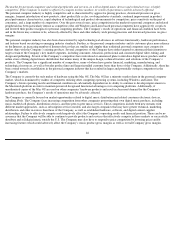Apple 2005 Annual Report Download - page 49
Download and view the complete annual report
Please find page 49 of the 2005 Apple annual report below. You can navigate through the pages in the report by either clicking on the pages listed below, or by using the keyword search tool below to find specific information within the annual report.
The Company also faces increased competition in the U.S. education market. U.S. elementary and secondary schools, as well as college and
university customers, remain a core market for the Company. Uncertainty in this channel remains as several competitors of the Company have
either targeted or announced their intention to target the education market for personal computers, which could negatively affect the
Company’s market share. In an effort to regain market share and remain competitive, the Company has been and will continue to pursue one-
to-one (1:1) learning solutions in education. 1:1 learning solutions typically consist of iBook portable systems for every student and teacher
along with a wireless network connected to a central server. These 1:1 learning solutions and other strategic sales are generally priced more
aggressively and could result in significantly less profitability or even in financial losses, particularly for larger deals. Although the Company
believes it has taken certain steps to strengthen its position in the education market, there can be no assurance that the Company will be able to
increase or maintain its share of the education market or execute profitably on large strategic arrangements. Failure to do so may have an
adverse impact on the Company’s operating results and financial condition.
The Company’s transition from PowerPC microprocessors used by Macintosh computers to microprocessors built by Intel is subject to
numerous risks.
In June 2005, the Company announced its intention to transition from the use of PowerPC microprocessors to the use of Intel microprocessors
in all of its Macintosh computers by the end of calendar year 2007. This transition is subject to numerous risks and uncertainties, including the
Company’s ability to timely develop and deliver new products using Intel microprocessors, the timely innovation and delivery of related
hardware and software products, including the Company’s applications, to support Intel microprocessors, market acceptance of Intel-based
Macintosh computers, the development and availability on acceptable terms of components and services essential to enable the Company to
timely deliver Intel-based Macintosh computers, and the effective management of inventory levels in line with anticipated product demand for
both PowerPC and Intel-based Macintosh computers. In addition, the Company is dependent on third-party software developers such as
Microsoft and Adobe continuing to support current applications that run on PowerPC-based computers and timely developing versions of
current and future applications that run on Intel and PowerPC-based Macintosh computers. The Company’s inability to timely deliver new
Intel-based products or obtain developer commitment both to continue supporting applications that run on PowerPC microprocessors and
timely transition their applications to run natively on Intel-based products may have an adverse impact on the Company’s results of operations.
The Company’s announcement of its intention to transition to Intel microprocessors may negatively impact sales of current and future
Macintosh products containing PowerPC microprocessors, as customers may elect to delay purchases until the Intel-based products are
available. Additionally, there can be no assurance that the Company will be able to maintain its historical gross margin percentages on its
products, including Intel-based Macintosh computers, which may adversely impact the Company’s results of operations.
Future operating results are dependent upon the Company
’s ability to obtain a sufficient supply of components, including microprocessors,
some of which are in short supply or available only from limited sources.
Although most components essential to the Company’s business are generally available from multiple sources, certain key components
including microprocessors and ASICs are currently obtained by the Company from single or limited sources. Some key components (including
without limitation DRAM, NAND flash-memory, and TFT-LCD flat-panel displays), while currently available to the Company from multiple
sources, are at times subject to industry-wide availability and pricing pressures. In addition, new products introduced by the Company often
initially utilize custom components obtained from only one source until the Company has evaluated whether there is a need for, and
subsequently qualifies, additional suppliers. In situations where a component or product utilizes new technologies, initial capacity constraints
may exist until such time as the suppliers’ yields have matured. The Company and other producers in the personal computer industry also
compete for various components with other industries that have
47
























